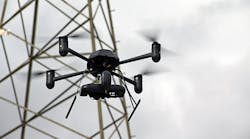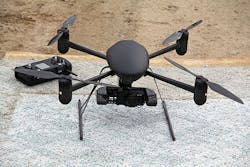The Drones Are Coming
In recent years, the use of flying unmanned aircraft — commonly referred to as drones — has evolved from the battlefield to everyday applications like wedding and real estate photography. Now Eversource is preparing to become one of the first utilities in the U.S. to formally use unmanned aircraft systems (UAS) as a safe, cost-effective and controlled way to inspect high-voltage, energized equipment in hard-to-reach terrain.
The Aerial Inspection Program
An aerial inspection program developed by Eversource and the department of engineering at Central Connecticut State University (CCSU) has become one of the first in the country to secure approval from the U.S. Federal Aviation Administration (FAA) to experiment with unmanned aircraft technology to determine the feasibility of inspecting high-voltage wires and structures more than 200 ft (61 m) tall. The approval is the culmination of a yearlong application process that started in the fall of 2013 and comes at a time when the commercial use of unmanned aircraft remains tightly controlled pending federal rules expected in 2016 and 2017, regulating their operation in civilian airspace.
Authorization
In June 2014, the FAA granted CCSU and Eversource a certificate of authorization to conduct flight testing in the wire zone of energized high-tension power lines. The team was officially the first to fly its baseline test aircraft at FAA-approved locations to determine the capabilities of UAS for line and structural inspections. Eversource has determined that using UAS for line and structural inspection is a cost-effective process with many benefits including preventive maintenance, which means improved reliability for customers.
To date, the team has logged more than 200 test flights in close proximity of transmission lines and support structures. The UAS is operated by a pilot and observer, and is only flown next to the lines and structures to survey the equipment. The aircraft is always in the crew’s line of sight and is not flown freely along the right-of-way.
The use of UAS is in response to the frequency of transmission inspections that have increased in recent years to meet stricter federal reliability standards for the bulk power grid. Transmission lines and support structures are regularly inspected for damage, such as from woodpeckers boring nests into wood poles, metal fatigue, corrosion, lightning strikes and vandalism. Already used regularly by utilities in Europe and New Zealand, the technology promises to increase worker safety and improve system reliability while reducing time and costs for certain inspections.
A New Approach
Deploying a UAS in the field provides a quicker, more cost-effective way to conduct spot inspections of transmission lines than by conventional means. For example, improving a single right-of-way access road to support a large bucket truck can cost an average of US$40,000 to $60,000 and take hours or days to complete. In contrast, Eversource has only about $30,000 invested in its entire UAS program and would be able to complete the same inspection in a matter of minutes.
A UAS also can do the job with minimal environmental impacts. It can be driven to areas near a transmission right-of-way in a light truck or sport utility vehicle, be quickly launched, and be flown over rugged or ecologically sensitive areas to inspect transmission structures and lines.
Using a UAS also greatly improves safety for utility workers. New Occupational Safety & Health Administration (OSHA) safety regulations to prevent falls went into effect in April 2015. These regulations also will prevent line workers from climbing and inspecting certain structures. Although they will still be able to climb wood transmission structures, most of Eversource’s taller steel structures would be outside the new safety requirements. In those instances, the controlled use of a UAS would allow workers to complete regular inspections.
Baseline UAS
The UAS control station and base developed by Eversource and CCSU includes a laptop computer loaded with telemetry and video software, a controller (joysticks) enabled with GPS lock technology and the UAS itself, a four-rotor quadcopter with a maximum takeoff weight of just 5.5 lb (2.5 kg) and measuring only 34 inches (0.9 m) wide between the tips of its rotor blades.
The unit is equipped with a camera zoom lens capable of taking video and still photos, and transmitting the images to the base station. The operator on the ground remotely guides the camera and aircraft, and sees the images in real time on the laptop display. The aircraft can remain aloft for more than 15 minutes, with 5 minutes in reserve for flying back to the launch point and landing.
For greater stability, the aircraft can operate in two modes. The altitude-hold mode enables the aircraft to maintain its current altitude with variable wind conditions while controlled by the operator. The GPS-position-hold mode allows the aircraft to maintain its position and altitude within a certain tolerance that relies on the signal strength of global positioning satellites in the area.
One of the great values of the UAS is in catching even small, emerging structural issues before they impact the flow of electricity. It can provide views of pole-top hardware, such as cotter pins, that would otherwise be difficult or impossible to see from helicopters or bucket trucks.
FAA Requirements
The FAA authorization granted to Eversource and CCSU limits flights to transmission rights-of-way at heights no greater than 400 ft (122 m). It also requires the aircraft be operated by a licensed pilot, and a qualified observer must be present for each flight. Both the pilot and observer must meet the FAA requirements, as outlined in the certificate of authorization for each approved location. Pilots are also required to take an oral and written flight exam that covers preflight inspection, operating procedures, basic maneuvers, modes of operation, operation in different orientations and emergency procedures.
Benefits Realized
Eversource looks forward to implementation of UAS technology. After more than 200 successful test flights, it has proven to be a safe and cost-effective tool for identifying maintenance requirements around transmission structures while minimizing environmental impacts. However, the most important benefits include greater safety for line workers, who may never have to leave the ground to inspect a 200-ft (61-m) tower, and improved system reliability for electric service customers.
Carl J. Tyburski ([email protected]) is a supervisor in the Eversource Energy transmission lines department with more than 30 years of experience in transmission and distribution line construction and maintenance. During this time, he has overseen imploding connector projects, live-line structure replacement, and the use of helicopters for maintenance and construction, while keeping workers safe first and always.
Alfred A. Gates ([email protected]) is a professor in the college of engineering at Central Connecticut State University. He has been involved with small unmanned aircraft systems (UAS) research since 2006. Some of the research includes the development of a fully autonomous pneumatic rifle-launched fixed-wing UAS funded by NASA and GPS-based multirotor collision avoidance funded by the U.S. Air Force. Currently, he is working on the development of a fixed-wing mortar launched micro-UAS funded by the U.S. Army and structural inspection using small multi-rotor unmanned aerial vehicles funded by Eversource. Gates, a commercial helicopter pilot and a fixed-wing pilot, has been involved with remote control aircraft for more than 20 years.



